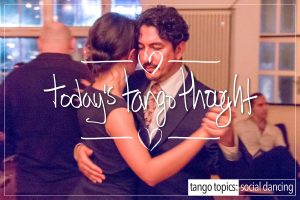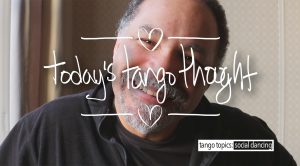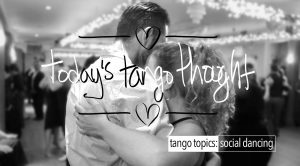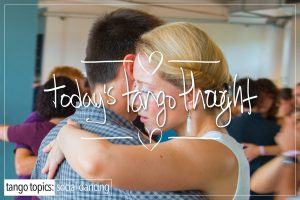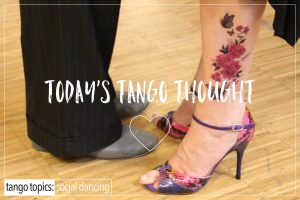Tango is a ‘Social’ dance. Meaning that the whole reason you are there is to hang out, meet new people, and to be social with each other. The dancing part is what brings us together but it’s really about being a social creature. That’s why it’s called a ‘Social’ dance. “Social” in this case means talking and sharing your day or what’s been going on with you. Mostly it’s lots of talking, sharing, listening, and more talking.
However one thing is true that probably no one told you, that the ‘talking’ part ends the moment your feet hit the floor and you’re in your partner’s embrace.
To be clear, there’s an axiom that the more advanced dancer adheres to for a variety of reasons: “If you’re talking, you’re not dancing”.
What does that really mean aside from the obvious STFU ? It means simply that IF you are talking to your partner AS you are dancing with them, you are more than likely (not always, but most certain more than likely) not really focused on dancing with them, nor your own technique, nor what’s happening around you, nor your embrace. Your balance, posture, stability, foot placement, leg trajectory, all suffer because you’re not focused on what you’re supposed to be doing. As a result you’ll start to miss things, you’ll start grabbing on for balance and stability, you’ll engage pressure (tsk!), compression (tsk!), tension (tsk!), force (tsk!). All because you’re rather focused on the talking part instead of the dancing part. Put simply, your technique suffers when you are talking instead of dancing. You forget how to execute ‘X’ properly because you’re too busy talking. Those wonderful private lessons you’re taking, will all go right out the window because you’re talking instead of dancing, instead of focusing on your dance.
Argentine Tango requires all of your focus, all of your awareness, not just some of it, not a piece but all of it. If you’re talking you’re going to miss things, very important little tiny things. And those little tiny things are the dance. The devil, in this case, really is in the details and when it comes to Argentine Tango the details matter, immensely.
Some people believe that they’re capable doing two or more things at once or multitasking. Studies have shown that when you’re ‘texting & driving’ things tend to not work out so well. The same is true here just without (thankfully) the deadly consequences. Unfortunately Argentine Tango doesn’t work that way. You need to focus all of your attention on the details, the nuance, and more importantly the music, and your partner. This is one reason why the better dancer in the room is ‘better’ because they’re not talking while they’re dancing. They save the talking part for either before the tanda, during the song breaks, or after the tanda, but not while they’re dancing with their partners.
Do what you want, but quite honestly, unless you can sing (ON KEY please), you’re doing nothing more than distracting your dance partner by talking to them while you believe you’re dancing with them. To be clear, this isn’t the tango police dictating to you how you should or shouldn’t social dance, nor is it arrogance, or anything else that would prevent you from hearing the message of Talk Less, Dance More. It is a simple reminder that talking is a distraction. Let the singer, the music, and the dancing do all the talking for you.


